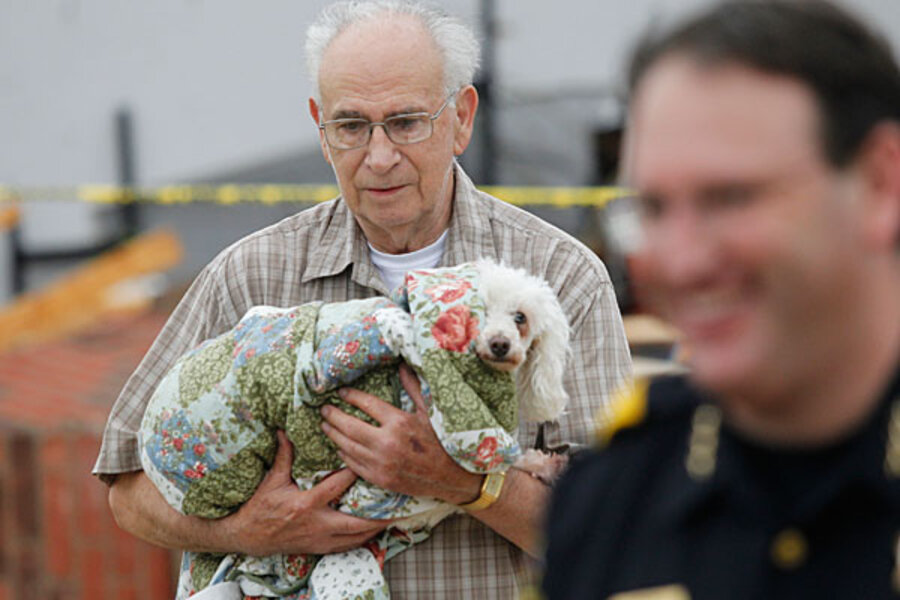Texas tornadoes: Why no fatalities after a dozen tornadoes?
| Dallas
Up to a dozen tornadoes skipped through the densely populated Dallas-Fort Worth area in Texas on Tuesday, ripping apart homes, tossing tractor-trailer trucks into the air and injuring at least 17 people, but there were no reported deaths.
Ten to 12 tornadoes touched down during a massive storm that brought chaos from high winds, rain and hail to the nation's fourth most populous metropolitan area, said National Weather Service meteorologist Jesse Moore. On Wednesday morning, more than 8,000 homes and business were still without electricity.
Many of the 6.3 million area residents were forced to scramble for safety Tuesday as the storm bore down during the early afternoon, when schools and workplaces were open.
Seven people were injured in the suburb of Arlington, police said. Most suffered only minor injuries but one person hit by a falling tree was in critical condition, said Arlington police spokeswoman Cheryl Carpenter.
In one of the hardest hit areas south of Dallas, Lancaster, tornadoes damaged 300 structures.
Of the 10 people injured in Lancaster, two of them were severely hurt, said Lancaster police spokesman Paul Beck.
Authorities were amazed that no one was killed given the intensity of the storm, the number of tornadoes and the population density of the area.
"We dodged a big bullet ... It really is a miracle," Dallas Mayor Mike Rawlings said in an interview on CNN.
As federal and state authorities assess the damage Wednesday, they will also be looking at the effectiveness of the warning systems and procedures.The fact that these were daylight tornadoes may have helped.
The survival rate from a tornado is higher during the daylight hours because people are more likely to hear or see the warnings and take cover, meteorologists said. Twisters are most deadly when people are sleeping at night, they said.
One tornado lifted trucks like toys in the Flying J Truck Plaza in Dallas, said truck driver Michael Glennon, who caught the destruction on his video camera as debris swirled through the air.
"We've seen roofs blown off, houses totally flattened, tractor-trailers knocked over," Moore said.
On Tuesday evening, the storm system moved east into Oklahoma, Arkansas and Louisiana with the potential of producing high winds and more tornadoes, Moore said.
Sixth-grader Hailey Pellerin said she and other students had just started lunch when teachers quickly herded students back to their classrooms in their southwest Arlington elementary school.
"We had to duck and cover for two hours," she said. The students were seated, lined up against a wall in their classrooms and covered their heads. "The power went out so it was dark and hot."
The tornado passed about 200 yards (180 meters) from the school, her father David Pellerin said.
"We were so lucky because it came so close but passed by the two schools my kids attend," said Pellerin, the father of three.
The National Weather Service is now testing a new tornado warning system – using stronger language and more graphic details about the potential effects. While the test was not used in Texas Tuesday, it is being tested in Kansas and Missouri. The National Weather Service is also trying to increase the amount of warning time before a tornado reaches an area.
US TORNADO SEASON STARTS EARLY
Some 110 planes were damaged by hail and 400 flights canceled at Dallas-Fort Worth International Airport, the eighth busiest in the world, stranding thousands of passengers. Another 40 incoming flights were diverted.
During the height of the storm, witnesses at the airport said the sky turned dark and passengers were herded away from windows and into stairwells and restrooms.
The U.S. tornado season has started early this year. Tornadoes have been blamed for 57 deaths so far in 2012 in the Midwest and South, raising concerns that this year would be a repeat of 2011, the deadliest year in nearly a century for the unpredictable storms.
In 2011, there were 550 tornado deaths, including 316 lives lost on April 27 in five southern states, and a massive tornado that killed 161 people in Joplin, Missouri, on May 22.
Tuesday's tornadoes in Texas could prove more costly than a hailstorm nearly a year ago in the Dallas area that caused more than $100 million in insured losses. That April 15, 2011, storm was less damaging in terms of hail and winds.
Insurers have already lost as much as $2 billion during the 2012 tornado season, mostly from a record March 2 outbreak. That follows record-breaking losses of $26 billion during the 2011 tornado season. (Additional reporting by Jon Nielsen, Marice Richter, Corrie MacLaggan, James Kelleher, Kyle Peterson, Ben Berkowitz and Karen Jacobs; Writing by Andrew Stern and Greg McCune; Editing by Lisa Shumaker)






